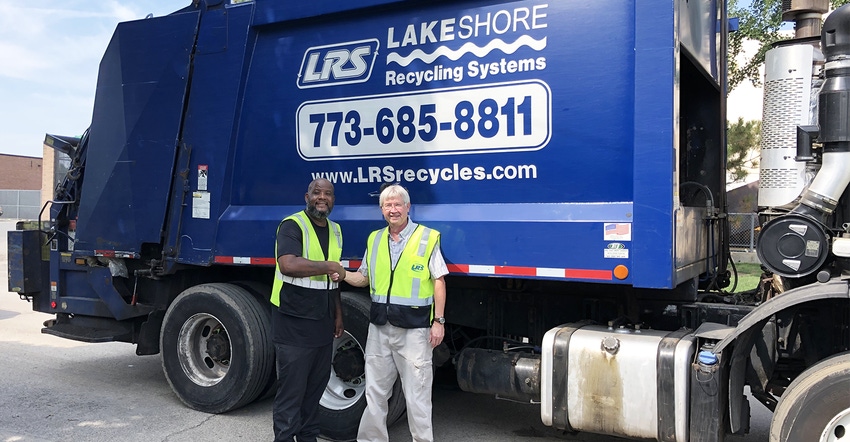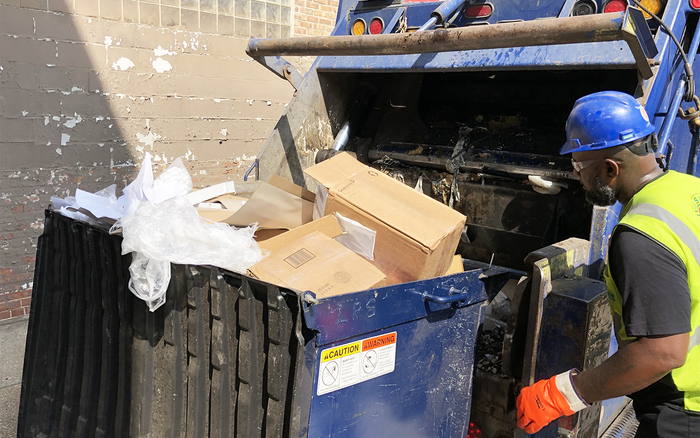My Garbage Truck Experience: Talking Trash and Recycling
A unique ride-along experience revealed as much about recycling as about trash hauling.

Life is full of surprises, for example a recent experience when I rode shotgun on a garbage truck.
I didn’t know it until about an hour before climbing aboard.
It was associated with the August 9 ribbon-cutting ceremony for Lakeshore Recycling Systems’ new $50 million recycling facility in Chicago. LRS held a media event the day before, and I was pleased to be a part of a select group of industry reporters to participate. The invite mentioned a “ride along” so I assumed that it would be for a truck picking up residential recyclables. I was looking forward to the experience.
I was wrong on both counts: it wouldn’t be residential, and it wouldn’t be picking up recyclables.
Which is how I ended up on the passenger side of a garbage truck servicing commercial customers in Humboldt Park in west Chicago. Commercial customers comprise schools, apartments, and businesses.
At first I was disappointed not to be aboard a recycling truck; however, I learned a valuable lesson or two about garbage and recycling along the way.
Trash-talk truck and tech: Man with a plan.
After reaching the meet-up location along his route, I found my designated driver Morye to be friendly, knowledgeable, highly accommodating, and responsive to my many questions. I learned he arose at 2:30 AM to avoid heavy traffic for his commute from across the border from Indiana. He was about half done with his stops when I joined him mid-morning.
Another surprise was how high the cab was, it was like climbing a ladder. I’m 60-something years old and reasonably fit, but I needed all my 6-foot frame to reach a handle high up on the door. Then I had to pull myself up with one hand while holding a notepad in the other.
Later I found it harder to exit backwards.
|
After a little trouble strapping in with an unfamiliar seatbelt style which was somewhat embarrassing as a start, we drove off to our first stop.
It’s up to the driver to determine his route working from a touchpad with a color-coded map of stops —locations are changed from red to blue after pickup — or an old-fashioned printed paper checklist.
Morye is a touchpad guy. His route this Tuesday went roughly from south to north in a back-and-forth horizontal pattern. It seemed a good way to do it, though route determination appears tailor-made for artificial intelligence.
Our first stop was at a landscaping company. As with other garbage trucks, Morye’s had a back-load design to pick up the trash-filled metal bins or carts; by comparison, residential recycling vehicles are side loading. The truck was slowly backed up to a sizable 11-cubic yard bin. I was instructed to stay in the cab as he got out and took care of business.
Bin unloading took longer than either of us expected, but that was because wood planks were wedged in the bottom of the bin. The truck shook as did I along with the extension arm on the truck he throttled to dislodge the material. At one point I grabbed a nearby handle when I saw the steering wheel slowly rotate indicating the front wheels were partly off the ground. It felt like a thrilling 10-minute carnival ride.
I looked in the rearview mirror when the shaking stopped to see Morye carefully picking up trash on the ground that didn’t make the transfer.
Trash talk: waste and packaging wasted.
I was permitted to exit the truck at the next stop, which was an automotive parts distributor conveniently in the same off-street industrial area just a couple hundred yards away. I observed how that was done as four 2-cubic yard trash carts awaited.
Morye says he sometimes needs to wrestle the cart into place, and this was one of those times. It weighs about 300 pounds empty, he told me, so it wasn’t easy to maneuver.
The driver rolls the cart firmly into position before he pushes a button to activate two curved bars that emerge to secure the cart’s handles, one on the left side and one on the right. Once locked in place, the cart is raised and rotated over the back end of the truck bed to discharge the contents. After all bins have been dumped, Morye engaged a sweeper arm on the truck bed that pulls trash forward to make room for the next stop.
The first of the bins was garbage. I was surprised to see the others were filled mostly or completely with packaging materials. These included some strapping and who knows what else, but most appeared to be loose film and corrugated boxes. I was shocked to see the latter, which comprise one of the most commonly and easily recycled of all packaging.
It seemed such a waste.
Another bin looked full of film, at least that’s what was all that was showing. Some of this may have been at-store recyclable as polyethylene, but here it's all trash headed to landfill.

I learned later that this customer didn’t have a recycling agreement with LRS or likely any other hauler. LRS indicated it would check to see if the company would be interested in recycling.
LRS services 5,978 commercial municipal waste collection sites like this, according to Dhiya Elmasri, general manager. By contrast, only 3,319 of those are also serviced for recyclables, Elmasri reports, which is a 55% recycling rate.
That’s a lot of upside potential, though potential is not reality.
I pondered the number of similar, small-to-medium sized commercial businesses throughout Chicago, across the country, and around the world.
Unlike prominent brand owners and packaging companies that take high-profile stances setting push goals on sustainability through Environmental, Social, Governance (ESG) directives, tens of thousands of companies like the auto parts business remain off the recycling grid.
It could be for lack of interest or simply their being oblivious to recycling as an option.
It’s also likely that, without any incentive to do so, they believe that just getting rid of the trash is enough of an expense.
My other disappointment was that my one-of-a-kind ride along would be just those two stops. I was just getting into the swing of things.
However, with the day growing warmer and the smell of garbage growing stronger it may have been for the better. My next stop was the recycling facility for presentations and a walk-through tour of LRS’ impressive operations, but that’s a tale for another day.
About the Author(s)
You May Also Like





